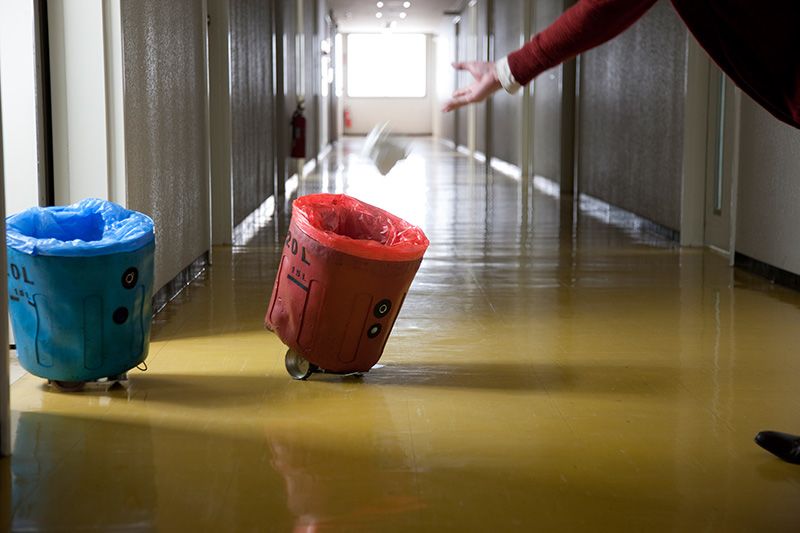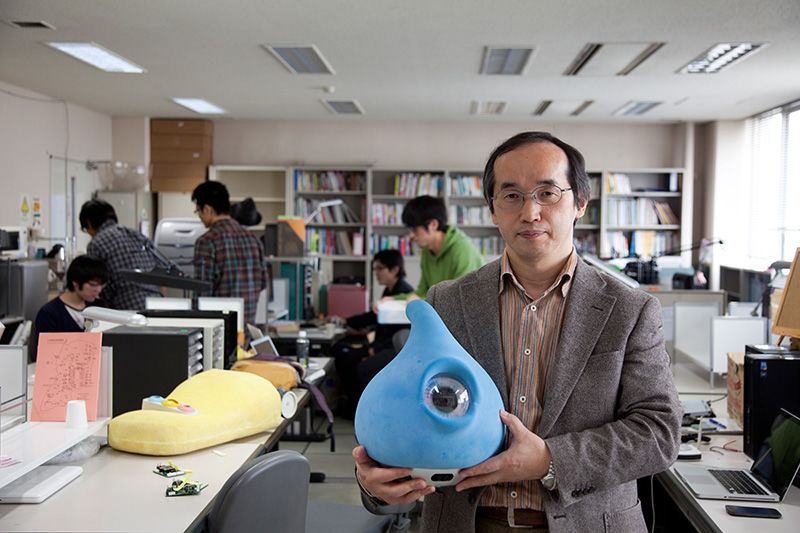nippon.com にて、〈弱いロボット〉を紹介していただきました。
(オリジナルは、ここです!)
ーーー
ロボットなのに人の助けを求める「ゴミ箱ロボット」
人間にゴミを拾ってもらったり、手を引いてもらったり―。豊橋技術科学大学(愛知県豊橋市)のロボットはユニークだけれど、少し頼りない。しかし、その弱さにこそロボットとの関係性を考えるヒントがあった。
部屋中をキレイにしてくれる掃除用ロボットが人気を集めているが、豊橋技術科学大学の岡田美智男教授らが開発した「Sociable Trash Box(通称、ゴミ箱ロボット)」は、なぜか掃除どころか自分でゴミを拾うこともできない。もちろん、ゴミ箱ロボットにはUSBカメラや赤外線センサー、車輪などが取り付けられている。しかし、室内をあちらこちら動き回ってゴミを見つけると、ロボットがするのは、人の方に身体を振り向け、お辞儀のように身体を傾けることだ。その頼りなくて愛嬌たっぷりの動きは、人に「ねえ、ゴミを拾うのを手伝って」と呼びかけているようだ。
 人間のアシストを引き出す「Social Trash Box」
人間のアシストを引き出す「Social Trash Box」
ロボットの多くは人間を助けるために開発される。その意味では人間の助けが必要なゴミ箱型ロボットは異色の存在だ。人間とロボットの共生する社会を考えるとき、確かにロボット個体としての完成度や完璧さも必要かもしれないが、それ以上に大切なのは人間とのコミュニケーション能力ではないだろうか。
 岡田研究室では社会的ロボティクスやコミュニケーションの認知科学をテーマに研究している。
岡田研究室では社会的ロボティクスやコミュニケーションの認知科学をテーマに研究している。
社会的ロボティクスやコミュニケーションの認知科学が専門である岡田教授は、ゴミ箱ロボットのように、ユニークだけれど頼りないロボットを通して、人間とロボットとの関係性を研究している。
「飲み物を買った後に、合成音で『アリガトウゴザイマシタ』と発する自動販売機があります。言葉の意味としては人間の店員による挨拶と同じですが、機械的な音声にはありがた味が感じられない。自販機に向かって返答する人もまずいないでしょう。これは人間と機械との間のコミュニケーションがうまくいっていない“好例”です」
弱さや頼りなさが引き出すコミュニケーション
 日常生活の中にロボットがいる。そんな共生社会がいずれ訪れるかもしれない。
日常生活の中にロボットがいる。そんな共生社会がいずれ訪れるかもしれない。
コミュニケーションにおいて言葉は必ずしも重要ではない。赤ん坊は大声で泣いてミルクやおむつ交換を要求するし、満足すれば泣きやんで意志表示する。母親は赤ん坊の泣き方や反応から要求をくみ取って世話をする。母親と赤ん坊の間には言葉はなくともコミュニケーションが立派に成立しているのだ。
しかも、子育ては母親から赤ん坊への一方的な行為ではなくて、母親と赤ん坊のインタラクションの上に成立している。赤ん坊は母親に世話され、欲しかったミルクを得ている。一方で、母親は赤ん坊に頼られることに喜びを感じ、我が子の世話をしながら自らの存在意義を確認している。言い換えれば、何も自分でできない赤ん坊は弱さや頼りなさによって、母親の愛情や助けを引き出し、その結果として目的を達成している。
こうした人間同士の自然で何気ないコミュニケーションを人間とロボットとの間でも実現できないか。岡田教授の研究は、そうした“共生”の実践に向けられている。何とも愛くるしい“ゴミ箱ロボット”は、その弱さを武器に周りの人のアシストを引き出してゴミを拾い集めるという目的を達成し、逆に人はロボットを助けてあげることで不思議な満足感や達成感を味わっている。もちろん、ゴミ箱ロボットと向き合うのが子どもであれば、ゴミ捨ての習慣も身につくかもしれない。
「人間とロボットがお互いの関わりの中で新たな価値を生み出し合う“Win-Win”の関係を築くこと、それが“共生”ではないでしょうか」。岡田教授の研究は続いている。
取材・文=林 愛子
撮影=川本 聖哉
Communication is the Key
Given the popularity of robots that vacuum your house for you, you might be surprised to hear that the “Sociable Trash Box” does not clean and cannot even pick up the trash by itself. Developed by Professor Okada Michio and others at the Toyohashi University of Technology, the trash-can robot has a USB camera and an infrared sensor installed. The robot moves around the room, searching for litter. When it finds some, instead of picking it up, it turns toward a person nearby and leans its body forward as if doing a bow. With this charming little movement you can imagine the robot saying, “Please help pick up the trash.”
Many robots are developed with the aim of helping people. From this perspective, a robot designed so that it requires help from people sounds very odd. In a society where humans and robots coexist, the latter will certainly need to have a complete set of functions—but the importance of their communication skills must not be overlooked.
“When you buy a drink from a vending machine, you may hear the machine say ‘Thank you’ in a synthesized voice. These are the same words that a shopkeeper would say, but the voice sounds impersonal and you don’t feel that the machine is grateful. Hardly anyone would turn back and reply. This is an excellent example of poor communication between machines and people.”
A Robot’s Body Language
Someday we may have robots with us in our everyday lives.
Words aren’t always necessary to communicate. Babies cry and scream, asking for more milk or a new diaper. They show their satisfaction by becoming quiet. Parents look after their babies by listening to the way they cry and looking at their reactions to work out what they want. Even though there are no words exchanged, a certain form of communication exists between them.
Indeed, rearing an infant is not a one-way process; it involves interaction between parent and child. The baby is cared for and gets the milk that it wants. The mother or father experiences joy in looking after the child and feels the significance of her or his existence to the child. To put it another way, the baby’s helplessness and weakness draw out its parents’ love and support, allowing it to achieve its aims.
Could this natural and unconscious form of human communication also take place between humans and robots? Okada’s research is looking carefully at how such a coexistence might take place. The adorable Social Trash Box uses its weakness as a weapon to coerce the people around it to pick up the trash. The people who help the robot get a strange sense of satisfaction and accomplishment. And of course, if the people around the robot are children, picking up the trash will be a good habit to learn.
Okada notes: “Coexistence between humans and robots is realized when they both create new value for one another, building a win-win relationship.” His research continues.
(Originally written in Japanese by Hayashi Aiko, science writer. Photographs by Kawamoto Seiya.)
